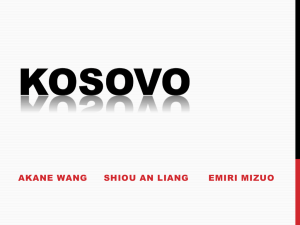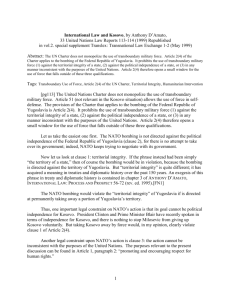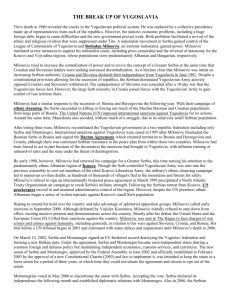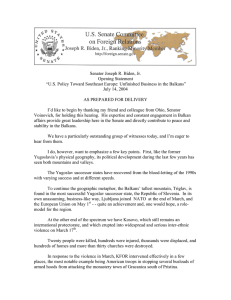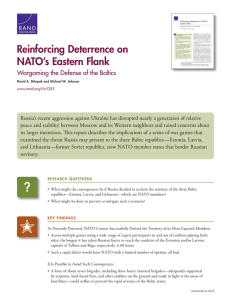Research Brief Why Milosevic Decided to Settle the
advertisement
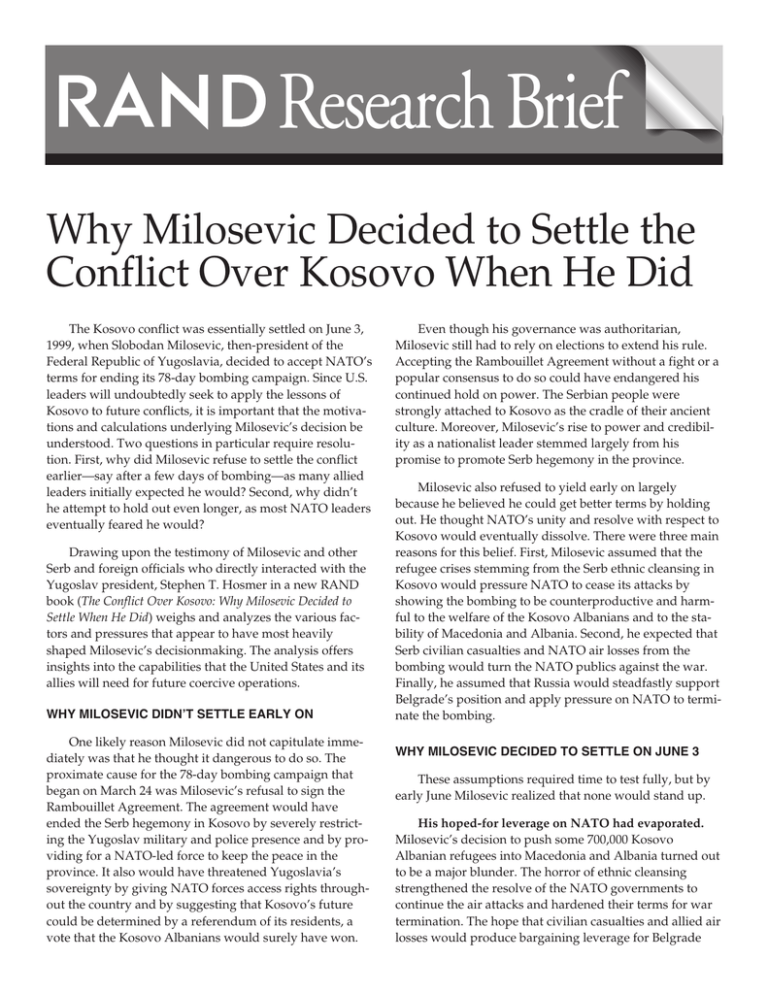
Research Brief Why Milosevic Decided to Settle the Conflict Over Kosovo When He Did The Kosovo conflict was essentially settled on June 3, 1999, when Slobodan Milosevic, then-president of the Federal Republic of Yugoslavia, decided to accept NATO’s terms for ending its 78-day bombing campaign. Since U.S. leaders will undoubtedly seek to apply the lessons of Kosovo to future conflicts, it is important that the motivations and calculations underlying Milosevic’s decision be understood. Two questions in particular require resolution. First, why did Milosevic refuse to settle the conflict earlier—say after a few days of bombing—as many allied leaders initially expected he would? Second, why didn’t he attempt to hold out even longer, as most NATO leaders eventually feared he would? Drawing upon the testimony of Milosevic and other Serb and foreign officials who directly interacted with the Yugoslav president, Stephen T. Hosmer in a new RAND book (The Conflict Over Kosovo: Why Milosevic Decided to Settle When He Did) weighs and analyzes the various factors and pressures that appear to have most heavily shaped Milosevic’s decisionmaking. The analysis offers insights into the capabilities that the United States and its allies will need for future coercive operations. WHY MILOSEVIC DIDN’T SETTLE EARLY ON One likely reason Milosevic did not capitulate immediately was that he thought it dangerous to do so. The proximate cause for the 78-day bombing campaign that began on March 24 was Milosevic’s refusal to sign the Rambouillet Agreement. The agreement would have ended the Serb hegemony in Kosovo by severely restricting the Yugoslav military and police presence and by providing for a NATO-led force to keep the peace in the province. It also would have threatened Yugoslavia’s sovereignty by giving NATO forces access rights throughout the country and by suggesting that Kosovo’s future could be determined by a referendum of its residents, a vote that the Kosovo Albanians would surely have won. Even though his governance was authoritarian, Milosevic still had to rely on elections to extend his rule. Accepting the Rambouillet Agreement without a fight or a popular consensus to do so could have endangered his continued hold on power. The Serbian people were strongly attached to Kosovo as the cradle of their ancient culture. Moreover, Milosevic’s rise to power and credibility as a nationalist leader stemmed largely from his promise to promote Serb hegemony in the province. Milosevic also refused to yield early on largely because he believed he could get better terms by holding out. He thought NATO’s unity and resolve with respect to Kosovo would eventually dissolve. There were three main reasons for this belief. First, Milosevic assumed that the refugee crises stemming from the Serb ethnic cleansing in Kosovo would pressure NATO to cease its attacks by showing the bombing to be counterproductive and harmful to the welfare of the Kosovo Albanians and to the stability of Macedonia and Albania. Second, he expected that Serb civilian casualties and NATO air losses from the bombing would turn the NATO publics against the war. Finally, he assumed that Russia would steadfastly support Belgrade’s position and apply pressure on NATO to terminate the bombing. WHY MILOSEVIC DECIDED TO SETTLE ON JUNE 3 These assumptions required time to test fully, but by early June Milosevic realized that none would stand up. His hoped-for leverage on NATO had evaporated. Milosevic’s decision to push some 700,000 Kosovo Albanian refugees into Macedonia and Albania turned out to be a major blunder. The horror of ethnic cleansing strengthened the resolve of the NATO governments to continue the air attacks and hardened their terms for war termination. The hope that civilian casualties and allied air losses would produce bargaining leverage for Belgrade went unrealized. The measures NATO leaders adopted to avoid the death or wounding of allies and to hold down enemy civilian casualties limited the active opposition to the war in the allied countries where important political constituencies harbored significant doubts about the NATO bombing. Moreover, Milosevic’s assumption that he could count on Russia’s continued backing also proved misguided. While Russian public opinion strongly supported Serbia, Boris Yeltsin believed that a protraction or escalation of the conflict would act against Russia’s economic interests in maintaining good relations with the West. NATO’s steadfastness, and the increasing talk of an invasion that Yeltsin feared would prove particularly harmful to Russia’s interests, eventually led Yeltsin to acquiesce to NATO’s bottom-line demands. The bombing produced a popular climate conducive to concessions. The initial popular response to the bombing had been one of patriotic defiance: the Serbian people rallied around the flag and Milosevic, and supported the Belgrade government’s refusal to yield on Kosovo. However, after a month or so of air attacks, the popular mood began to change: people became increasingly war weary, concerned with their daily survival, and desirous for the bombing to end. The change in public mood was such that Milosevic could now make concessions that might have cost him his power before the air attacks began. Indeed, when the conflict ended there were no demonstrations against the peace terms, even by the radical nationalists who had vowed never to allow foreign forces to enter Kosovo. Damage to “dual-use” infrastructure generated growing pressure within the regime for compromise. By early June, the bombing was apparently perceived to be causing a magnitude of damage to Serbia’s infrastructure and economy that, if allowed to continue, could eventually threaten the regime’s survival. In addition, the air attacks were creating stress, hardships, and costs for members of the ruling elite. Most of this pressure resulted from NATO attacks on six types of fixed infrastructure targets located mainly in Serbia: command, control, and communications; leadership; lines of communication; electric power; industrial plants; and petroleum, oil, and lubricants facilities. The vast majority of these targets were of the “dual-use” variety in that they served a civilian as well as a military function. Damage to Yugoslav military forces and the “resurgence” of the Kosovo Liberation Army generated little pressure. Even though purely military targets were the primary focus of the NATO air campaign, air attacks on such targets probably did not greatly concern Milosevic. Most of the purely military facilities struck by NATO were empty of personnel and equipment when hit, and the amount of Yugoslav army armor and artillery lost to NATO air attacks constituted only a small percentage of total inventories. Nor is there evidence that the purported “resurgence” of the Kosovo Liberation Army (KLA) in Kosovo significantly affected Milosevic’s decision to yield. Even at the end of the conflict, Yugoslav military and security forces continued to dominate the battlefield in Kosovo. Milosevic expected unconstrained bombing if NATO’s terms were rejected. The evidence suggests that the key reason Milosevic accepted NATO’s terms on June 3 was his fear of the bombing that would follow if he refused. Milosevic and his colleagues believed that NATO was poised to launch a “fierce” and unconstrained bombing campaign if its peace terms—which had now been endorsed by Russia—were rejected. The Serb leaders were convinced that NATO was prepared to employ “massive bombing” to demolish their country’s entire infrastructure—including its remaining bridges, electric power facilities, telephone systems, and factories. Milosevic apparently calculated that the Serbian public would neither long tolerate nor forgive him for the hardships that would result from such intensified bombing, particularly if its more extreme effects—such as a continuous, nationwide power outage—carried over into the harsh Balkan winter. He therefore concluded that a continued refusal to make peace would likely cost him his hold on power. He probably also worried about the threat of future invasion. The increasing talk of an eventual NATO ground invasion was probably another, though lesser, factor in Milosevic’s decision. While Milosevic had reason to view an invasion as a more distant threat—it would have taken NATO two to three months to deploy sufficient troops within the theater for a ground attack—he may have worried that a future ground conflict might not be confined to Kosovo and could directly endanger his power, safety, and freedom. Milosevic believed NATO’s terms were the best he could get. Finally, Milosevic acceded to NATO’s demands because he was convinced that NATO’s terms were unlikely to improve and realized that the agreement being offered provided him with some political cover. While certain terms, such as the requirements governing the withdrawal of Yugoslav forces from Kosovo, were less favorable than those contained in the Rambouillet Agreement, other terms could be portrayed as improvements. NATO’s access was now limited only to Kosovo; there was no longer a suggestion that Kosovo’s future would be decided by a referendum; and Yugoslavia’s territorial integrity and sovereignty with respect to Kosovo were reaffirmed by the Security Council. Thus, even though NATO’s basic demands were satisfied, Milosevic could still claim a victory of sorts. U.S. FORCES NEED THE CAPABILITIES AND FREEDOM OF ACTION TO COERCE FUTURE ADVERSARIES Drawing upon the lessons of the Kosovo experience, the author makes two recommendations relating to the coercive use of air power in future conflicts. Improve capabilities to locate, identify, and rapidly strike enemy mobile targets. NATO’s attempts to “systematically” and “progressively” destroy Yugoslav military forces and thereby pressure Milosevic to come to terms proved largely unsuccessful. The Yugoslavs were able to preserve intact the vast bulk of their ground forces by dispersing them before the bombing began and by making extensive use of concealment, civilian shielding, and hardened underground shelters. To better counter such tactics in future conflicts, the United States and its allies must seek to develop sensors, surveillance and reconnaissance platforms, target processing and dynamic control measures, weapon systems, and concepts of operation that will improve their ability to attack enemy armor and artillery forces when such forces are widely dispersed, hidden under foliage, or located in civilian settings. To minimize civilian casualties, extremely accurate low-yield munitions will be required to attack enemy military forces located in or near civilian structures. Special munitions will also be required to effectively attack enemy leadership and command, control, and communication facilities that are located deep underground. Preserve the option to attack dual-use targets. In the Kosovo conflict, it was the attacks and threat of additional attacks on dual-use infrastructure targets that generated the decisive pressure for war termination. In future conflicts, such attacks may be the most effective—and in some instances, the only feasible—way to coerce enemy decisionmakers to accept U.S. peace terms. However, attacks on dual-use targets may carry a particular risk of legal sanction in that the military utility and therefore the legitimacy of a given target can differ with the eye of the beholder. American decisionmakers and military personnel may be reluctant to order or conduct attacks on dualuse targets if they believe such action could expose them to prosecution as “war criminals.” Therefore, the United States must not assume binding obligations that could subject U.S. personnel to possible prosecution and conviction by an international court for directing or conducting attacks on targets that responsible U.S. legal authorities had certified to be legitimate military targets. But to comply with laws of war and to retain the political support needed to sustain military interventions, the United States and allied forces will also need to maximize their capability to attack such dual-use targets with minimal loss of civilian life and other unintended damage. RAND research briefs summarize research that has been more fully documented elsewhere. This research brief describes work done for RAND’s Project AIR FORCE; it is documented in The Conflict Over Kosovo: Why Milosevic Decided to Settle When He Did, by Stephen T. Hosmer, MR-1351-AF, 2001, 162 pp., ISBN 0-8330-3003-5, available from RAND Distribution Services (Telephone: 310-451-7002; toll free 877-584-8642; FAX: 310-451-6915; or email: order@rand.org). Abstracts of all RAND documents may be viewed on the World Wide Web (www.rand.org). Publications are distributed to the trade by NBN. RAND ® is a registered trademark. RAND is a nonprofit institution that helps improve policy and decisionmaking through research and analysis; its publications do not necessarily reflect the opinions or policies of its research sponsors. R 1700 Main Street, P.O. Box 2138, Santa Monica, California 90407-2138 • Telephone 310-393-0411 • FAX 310-393-4818 1200 South Hayes Street, Arlington, Virginia 22202-5050 • Telephone 703-413-1100 • FAX 703-413-8111 201 North Craig Street, Suite 102, Pittsburgh, Pennsylvania 15213-1516 • Telephone 412-683-2300 • FAX 412-683-2800 RB-71 (2001)
